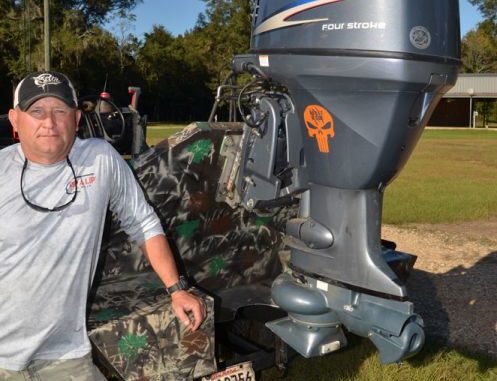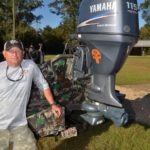
Todd McElveen’s river boat started out life as a 16-foot Xpress welded jon boat. But it didn’t stay that way, getting highly modified to adapt it for use in shallow rivers with a jet drive outboard motor.
Most noticeable is the giant elevated transom that towers approximately 3 feet above gunnel level. A hydraulic jack plate is mounted on the back of the transom, and the motor is mounted on the jack plate.
For use on the river, the motor is jacked well up on the plate. “When you run a jet foot, a quarter-of-an-inch can make a major difference in performance,” stressed McElveen.
This set-up allows the boat to be used with a prop foot for conventional deep water use as well. “It only takes 30 minutes to change the foot. In lakes, any chop on the water will cause the motor to suck air into the intake of a jet foot. They aren’t good in vegetation, either.”
A jet foot costs $2,250 un-installed, according to McElveen, and the changeover will result in a horsepower reduction. With the jet foot, McElveen’s 115 Yamaha is rated as a 90 horsepower motor.
A hull adaptation necessary to use a jet foot motor is a 2-inch-deep tunnel built into its bottom. The tunnel provides a protected niche for the foot, and allows the boat to run in shallower water than it could without it.
Another adaptation is the addition to two pontoons on the stern of the boat. These provide extra flotation to keep the stern riding higher, improving shallow water performance.
McElveen also has made some additional personal modifications to his boat. He had aluminum half-rounds welded over both outer-runners under the boat to allow it to jump over logs without scraping the hull.
Then, to add strength, he had 3/16-inch diameter aluminum plates welded between the runners on the boat’s bottom.
To top things off, McElveen built a 17.5-gallon baffled fuel tank into the bow to shift weight from the stern forward. Finally, he doubled the length of the bow deck rearward, and decked over the area between the rear bench seat and the transom. The latter changes provides stable platforms for anglers while fishing the turbulent river.
River boats can be purchased or custom-built. According to McElveen, Dockside Marine (985-732-7600), a boat dealer in Bogalusa, has developed a niche market in the boats.
Scott Gilly, owner of Southern Aluma-Werks (985-515-0695), is an independent builder in Enon very near the Bogue Chitto. Gilly builds river boats, as well as other aluminum products, from scratch, custom-designed to buyers’ specifications.
And about that trolling motor
There is a good reason for the Rube Goldberg-looking trolling motor on the bow of McElveen’s boat. A combination of strong currents and lots of logs can quickly make a pretzel out of most trolling motors shafts.
The motor, donated by Schilling for the cause, has large garage door springs mounted on eye bolts instead of stiff metal struts. If the motor hits an obstruction head-on, the springs allow the trolling motor head and shaft to fold beneath the boat almost flush to the bottom of the hull.
After the obstruction is passed, the springs pull the motor back into position. “You will not bend a shaft with a breakaway motor,” predicted McElveen confidently.

